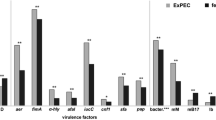Abstract
Hemagglutination (HA) tests using human and bovine erythrocytes and microagglutination tests using pili-specific antisera (PSA) were performed to examine 168 strains ofEscherichia coli belonging to enterotoxin-associated serotypes for colonization factors (CFs). Seventy-one (42%) of these 168 strains possessed at CF, but only 10 (6%) were found positive by both HA and PSA tests. Groups of test strains from different sources (feces, urine, blood, and wounds) were not found to contain statistically different percentages of CF-positive strains. Strains producing heat-stable enterotoxin alone were less frequently associated with a CF than were other enterotoxigenic and nonenterotoxigenic strains. Strains showing heat-labile hemolytic activity and belonging to serotype O6: H—were less likely (P=0.014, Fisher's exact probability) to contain a CF than were similarly hemolytic strains belonging to other serotypes.
Similar content being viewed by others
Literature Cited
Chabanon, G., Hartley, C. L., Richmond, M. H. 1979. Adhesion to a human cell line byEscherichia coli strains isolated during urinary tract infections. Journal of Clinical Microbiology10:563–566.
DeBoy, J. M., Wachsmuth, I. K., Davis B. R. 1980. Hemolytic activity in enterotoxigenic and nonenterotoxigenic strains ofEscherichia coli. Infection and Immunity29:193–198.
DeBoy, J. M., Wachsmuth, I. K., Davis, B. R. 1980. Serotypes of enterotoxigenicEscherichia coli isolated in the United States. Infection and Immunity29:361–368
Deneke, C. F., Thorne G. M., Gorbach, S. L. 1979. Attachmen pili from enterotoxigenicEscherichia coli pathogenic for humans. Infection and Immunity26:362–368.
Duguid, J. P., Cleeg, S., Wilson, M. I. 1979. The fimbrial and nonfimbrial hemagglutinins ofEscherichia coli. Journal of Medical Microbiology12:213–227.
Evans, D. G., Evans, D. J. 1978. New surface-associated heatlabile colonization factor antigen (CFA/11) produced by enterotoxigenicEscherichia coli of serotypes O6 and O8. Infection and Immunity21:638–647.
Evans, D. G., Evans D. J., Tjoa, W. S., DuPont, H. L. 1978. Detection and characterization of colonization factor of enterotoxigenicEscherichia coli isolated from adults with diarrhea. Infection and Immunity19:727–736.
Evans, D. G., Satterwhite, T. K., Evans, D. J., DuPont, H. L. 1978. Differences in serological responses and excretion patterns of volunteers challenged with enterotoxigenicEscherichia coli with and without the colonization factor antigen. Infection and Immunity19:883–888.
Evans, D. G., Silver, R. P., Evans, D. J., Chase, D. G., Gorbach, S. L. 1975. Plasmid-controlled colonization of factor associated with virulence inEscherichia coli enterotoxigenic for humans. Infection and Immunity22:656–667.
Evans, D. J., Evans, D. G., DuPont, H. L. 1979. Hemagglutination patterns of enterotoxigenic and enteropathogenicEscherichia coli determined with human, bovine, chicken, and guinea pig erythrocytes in the presence and absence of mannose. Infection and Immunity23:336–346.
Evans, D. J., Evans, D. G., DuPont, H. L., Ørskov, F., Ørskov, I. 1977. Patterns of loss of enterotoxigenicity byEscherichia coli isolated from adults with diarrhea: Suggestive evidence for an interrelationship with serotype. Infection and Immunity17:105–111.
Fusco, P., Polen, S., Hagerty, C., Wood, S., Brinton, C. 1981. Regulation of expression and serological classification ofEscherichia coli somatic pili. Abstract of the Annual Meeting of the American Society for Microbiology1981:32.
Gyles, C. L., So, M., Falkow, S. 1974. The enterotoxin plasmids ofEscherichia coli. Journal of Infectious Diseases130:40–49.
Jones, G. W., Rutter, J. M. 1972. Role of K88 antigen in the pathogenesis of neonatal diarrhea caused byEscherichia coli in piglets. Infection and Immunity6:918–927.
Ljungh, A., Faris, A., Wadström, T. 1979. Hemagglutination byEscherichia coli in septicemia and urinary tract infections. Journal of Clinical Microbiology10:477–481.
Moon, H. W., Kohler, E. M., Schneider, R. A., Whipp, S. C. 1980. Prevalence of pilus antigens, enterotoxin types, and enteropathogenicity among K88-negative enterotoxigenicEscherichia coli from neonatal pigs. Infection and Immunity27:222–230.
Moon, H. W., Nagy, B., Isaacson, R. E., Ørskov, I. 1977. Occurrence of K99 antigen onEscherichia coli isolated from pigs and colonization of pig ileum by K99+ enterotoxigenicE. coli from calves and pigs. Infection and Immunity15:614–620.
Satterwhite, T. K., Evans, D. G., DuPont, H. L., Evans, D. J. 1978. Role ofEscherichia coli colonization factor antigen in acute diarrheal. Lancetii:181–184.
Schaeffer, A. J., Falkowski, W. S., Halsey, W. F., Jones J. J., Duncan, J. L. 1981. Mannose sensitive adherence ofEscherichia coli to epithelial cells. Abstracts of the Annual of Meeting of the American Society for Microbiology1981:29.
Shapiro, J. A. 1969. Mutations caused by the insertion of genetic material into the galactose operon ofEscherichia coli. Journal of Molecular Biology40:93–105.
Smith, H. W., Halls, S. 1967. The transmissible nature of the genetic factor inEscherichia coli that controls haemolysin production. Journal of General Microbiology47:153–161.
Smith, H. W., Linggood, M. A. 1971. Observations on the pathogenic properties of the K88, Hly, and Ent plasmids ofEscherichia coli with particular reference to porcine diarrhea. Journal of Medical Microbiology4:467–485.
So, M., Heffron, F., McCarthy, B. J. 1979. TheE. coli gene encoding heat stable toxin is a bacterial transposon flanked by inverted repeats of 1S1. Nature277:453–456.
Thorne, G. M., Deneke, C. F., Gorbach, S. L. 1979. Hemagglutination and adhesiveness of toxigenicEscherichia coli isolated from humans. Infection and Immunity23:690–699.
Vosbeck, K., Svanborg Eden, C. 1981. Adhesion ofE. coli to uroepithelial cells and to tissue culture cells. Abstracts of the Annual Meeting of the American Society for Microbiology1981:31.
Vosti, K. L. 1979. Relationship of hemagglutination to other biological properties of serologically classified isolates ofEscherichia coli. Infection and Immunity25:507–512.
Author information
Authors and Affiliations
Rights and permissions
About this article
Cite this article
DeBoy, J.M., Thorne, G.M., Deneke, C.F. et al. Colonization factors andEscherichia coli belonging to enterotoxin-associated serotypes. Current Microbiology 6, 49–53 (1981). https://doi.org/10.1007/BF01566726
Issue Date:
DOI: https://doi.org/10.1007/BF01566726




